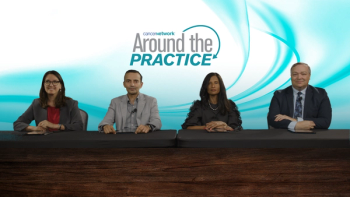
Oncology NEWS International
- Oncology NEWS International Vol 9 No 2
- Volume 9
- Issue 2
IFN-g Increases Rituximab Binding to Multiple Myeloma Plasma Cells
BOSTON-Interferon-gamma (IFN-g) triggers expression of CD20 on otherwise non-expressing multiple myeloma cells and may set them up for destruction by anti- CD20 monoclonal antibodies such as rituximab (Rituxan), Steven P. Treon, MD, PhD, of Dana-Farber Cancer Institute reported at the ASH meeting. Rituximab is an appealing therapeutic agent because of its relative lack of toxicity, but other studies have shown that in multiple myeloma, it is effective primarily in patients with CD20+ cells.
BOSTONInterferon-gamma (IFN-g) triggers expression of CD20 on otherwise non-expressing multiple myeloma cells and may set them up for destruction by anti- CD20 monoclonal antibodies such as rituximab (Rituxan), Steven P. Treon, MD, PhD, of Dana-Farber Cancer Institute reported at the ASH meeting. Rituximab is an appealing therapeutic agent because of its relative lack of toxicity, but other studies have shown that in multiple myeloma, it is effective primarily in patients with CD20+ cells.
The mechanism of CD20 induction by IFN-g is related to upregulation of PU.1, a transactivator of CD20 which is down-regulated with B-cell differentiation to plasma cells, Dr. Treon explained. IFN-g is also attractive because it has single-agent activity in multiple myeloma. IFN-g has antiproliferative and cytotoxic effects on multiple myeloma cell lines and on fresh multiple myeloma patient bone marrow plasma cells, Dr. Treon continued. In phase I/II clinical trials, response rates up to 15% have been reported with use of IFN-g in relapsed multiple myeloma patients.
Changes in CD20
To test whether dosing multiple myeloma cells with IFN-g would upregulate CD20 expression and whether this would translate into increased binding of rituximab by the treated cells, researchers set up cell cultures. These included plasma cells from 20 multiple myeloma patients, B cells from 9 multiple myeloma patients, B cells from 5 chronic lymphocytic leukemia patients, B-cells from 11 normal donors, plasma cells from 3 normal donors, and CD34+ hematopoietic progenitor cells from 5 normal donors. Each type of cell was cultured with and without IFN-g at 1 to 100 µ/mL for 48 hours. Changes in CD20 expression were evaluated with multicolor flow cytometry.
Binding of rituximab to cells from a multiple myeloma cell line (RPMI 8226) and to plasma cells from multiple myeloma patients was also measured before and after treatment with IFN-g.
Rituximab Binding Increased
Dr. Treon reported that these studies demonstrated that IFN-g increases the number of cells that express CD20 and increases the intensity of CD20 expression by individual cells in cultures of multiple myeloma plasma cells, multiple myeloma B cells, and normal donor plasma cells. IFN-g did not change CD20 expression in the other cells tested. The changes in CD20 expression correlated with expression of PU.1. Interestingly, the levels of IFN-g receptor expression did not correlate with these differences in effect on CD20 expression.
Rituximab binding to the multiple myeloma cell line and to cultured plasma cells from multiple myeloma patients increased following culture with IFN-g. IFN-g upregulates CD20 expression on multiple myeloma patient B cells and on multiple myeloma patient plasma cells, Dr. Treon noted.
IFN-g increases rituximab binding to multiple myeloma plasma cells. IFN-g increases Fc receptor expression in natural killer (NK) cells and monocytes and augments NK and monocyte ADCC activity, Dr. Treon added.
Induction of CD20
IFN-g selectively induces CD20 expression on multiple myeloma B cells and plasma cells at concentrations that are achievable pharmacodynamically and facilitates binding of rituximab. Induction of CD20 on multiple myeloma cells occurs as early as 6 hours and maximizes at 24 hours following culture with IFN-g. Sequential administration of IFN-g on day 1 and 3 provided for maximal induction of CD20.
These data provide a rationale for combining IFN-g with CD20-directed serotherapies for multiple myeloma. Dr. Treon said that the researchers are considering conducting a combination IFN-g/rituximab study in multiple myeloma patients.
Articles in this issue
almost 26 years ago
Neoadjuvant Docetaxel Increases Response Rate in Large Breast Tumorsalmost 26 years ago
Faslodex, a Pure Antiestrogen, Shows Antitumor Activityalmost 26 years ago
Consider Node Dissection, Adjuvant Therapy in Elderly Breast Cancer Patientsalmost 26 years ago
Tumor-Associated Proteases Predict Outcome in Node-Negative Patientsalmost 26 years ago
Herceptin Plus Vinorelbine a Promising Combination in Advanced Breast Canceralmost 26 years ago
Small Risk of Breast Cancer Death After Invasive Recurrence in DCIS Patientsalmost 26 years ago
Paclitaxel/Herceptin Effective in Metastatic Breast Canceralmost 26 years ago
Conservative Surgery Alone Not Sufficient to Prevent RecurrenceNewsletter
Stay up to date on recent advances in the multidisciplinary approach to cancer.


![“[This approval] will be a quite dramatic change in our philosophy and practice in multiple myeloma," according to Joseph Mikhael, MD, MEd, FRCPC, FACP, FASCO.](https://cdn.sanity.io/images/0vv8moc6/cancernetwork/3cab3ada4c023b68c118240a512e31d72a7f931b-1200x628.png?w=350&fit=crop&auto=format)

















































































